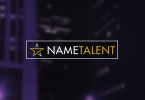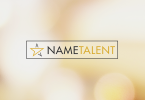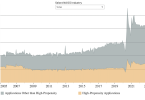One of the many benefits of attending NamesCon is you get a wealth of information from various vendors. In this post I take a look at some numbers that BrandBucket provided to conference delegates, with the goal of deciding the profitability for domainers of selling names there.
Background
BrandBucket was the original brandable marketplace offering a carefully curated selection of available domain names suitable for business names. They have been in business since 2007, and state that their sales have increased each year.
Domain investors submit potential domain names to BrandBucket, pay a small evaluation fee (currently $1), and some are selected for inclusion at BrandBucket (their documentation suggests that roughly 10% are selected). For these selected names the domain investor pays an additional $9 (one-time) listing fee (although at the time of writing that is being waived).
BrandBucket requires an exclusive listing, and you point your domain name servers to their site (or forward to it). A professional logo is included with each domain name, and you designate between $100 and $500 for the logo designer. BrandBucket suggest a price for your domain name, and the logo fee is added to that. You can adjust the price by a certain amount, if you wish.
The commissions are significantly higher than at the general purpose domain marketplaces such as Afternic, Sedo and Undeveloped, at 30% for most sales on their platform. Depending on your region and payout choices there may be additional fees related to payout.
2018 BrandBucket Sales Statistics
I had wondered how important BrandBucket was to the domain community, and the 2018 numbers provide an indication. In the most recent year 141 sellers sold a single domain name on their marketplace, while 119 sellers sold multiple names.
In 2018 the top ten sellers at their site sold an average of 50 names!
For some domain investors, BrandBucket is indeed a major source of revenue. In 2018 the top ten sellers at their site sold an average of 50 names! In other words the top ten sellers make a very decent living just from sales at this one venue. If your goal is to make a salary from domain investing, one option is to sell exclusively brandable names through a market such as BrandBucket.
Some Big Sales at BrandBucket
I had assumed that almost all of the sales at their market would be in the $2000 to $4500 range, but that turns out not to be true. In 2018 alone there were 9 sales over $100,000. So even if you have some pretty elite premium names, BrandBucket may be an appropriate sales venue.
In 2018 alone there were 9 sales over $100,000 on BrandBucket.
BrandBucket Average Data Past Five Years
Over the past 5 years there were 4538 domain names sold at an average price of about $3000 if you exclude sales above $10,000 to get a figure more representative of what most sellers will experience. These sales were spread over 648 different sellers. BrandBucket have paid out to domainers just over $12 million over the same period.
A Deeper Look At The Numbers
The numbers presented above came directly from BrandBucket documentation. I decided to use this data, along with some other numbers and calculations, to see how profitable, on average, it is to list domain names on BrandBucket.
BrandBucket is huge (some users have complained that there are so many options for companies that it is hard to get noticed). On their website BrandBucket say they have over 50,000 domain names available, and have confirmed to me that currently it is about 54,000. Now they have grown steadily, and a few years ago the number was 24,000 available domains. I have assumed the midpoint of the two numbers, 39,000, as a reasonable average number of available domains over the past 5 years.
We can combine this with average of 908 sales per year to compute the probability of a single name selling in one year of about 2.3%. That is the same order of magnitude as the overall throughput rate of about 1% often used in the industry.
The probability of a single domain name selling on BrandBucket in one year is about 2.3%. The average sales price is $3000 (if you exclude sales over $10,000 to get a figure representative of the experience for most sellers on their platform).
As we have noted in other analysis, the key question for domain profitability is whether the probability of sale in a year multiplied by the net proceeds from a sale is more than the yearly holding costs of the domain name.

The gross price on average is $3000, although it is important to realize that the actual value is higher since BrandBucket excluded all sales above $10,000 in calculating the $3000 figure. We will use the $3000 figure, but should keep that in mind. From that one needs to subtract the logo fee ($100 to $500) as well as the commission and the acquisition costs to get a net figure. They have a 30% commission structure (for sales under $50,000) so from $3000 you would obtain about $2100 (possibly minus some small payout charges possibly). If we assume a logo fee of $200, the net reduces to about $1900.
You also pay a $1 evaluation fee plus a one time $9 listing fee (currently waived). They say they accept about 10% of submitted names so probabilistically you would need to pay about $10 + $9 for each successfully listed name (if we return to a time when it is not waived).
You also have the cost that you paid to obtain the domain name. This probably varies extensively from registration fee to many hundreds of dollars. If I assume an average of $150, plus the $19, the net return would be $1731.
If we multiply that by the 2.3% by $1731 we obtain $39.80 as the maximum annual costs for the break even point. For a .com domain your annual costs are about $10, possibly slightly less, so it seems clear that if you can be as successful as the average domain investor using NameBucket, using the marketplace is indeed profitable.
…if you can be as successful as the average of those who place names on there, selling domain names on BrandBucket is indeed profitable.
The astute reader might note that only 10% of submitted names are accepted, so there would be an unaccounted costs for one year registration of names that were not accepted. Handling this properly is a little tricky. If we count those 9 other domain names as a loss in a single year, then our cost analysis would say that it is not profitable. However, if it could be argued that those names could be sold elsewhere, so no accounting need be made. Clearly those who are successful at BrandBucket will be those who have a higher acceptance ratio and also leave names on BrandBucket for multiple years so that the impact of the cost of registration of names not selected are spread out over more BrandBucket sales.
Other Brandable Marketplace Options
BrandBucket are no longer the only player in the brandable market, although they are the best known. Among the other choices are BrandDo, BrandPa, BrandRoot, Lysted and Namerific. A newer entry, SquadHelp, that started as a service for crowd suggestions of domain names, has now emerged as a significant marketplace of brandable domain names.
Successful Investors Views
Their documentation also provides quotations from three of their successful sellers. Michael Bilde of Embrand explains why he likes BrandBucket:
“To me, BrandBucket is the perfect relationship. I get to do what I enjoy the most. Research and buy brandable domains. Then I leave the pricing, marketing and sales to BrandBucket.”
– Michael Bilde, Embrand
Mark Levine, who was on a DNWire podcast a few months ago talking about his successful 2018 selling year, points out that:
“Only 8% of my portfolio is on BrandBucket, yet in 2018, 33% of my domain sales were through it.”
– Mark Levine
Final Thoughts
I don’t invest significantly in brandable names and have never submitted any names to BrandBucket for consideration. These numbers have convinced me that if you can do a good job of picking names likely to be accepted, and if you are able to obtain names at reasonable prices, brandable marketplaces like BrandBucket make economic sense.
…if you can do a good job of picking names likely to be accepted, and if you are able to obtain names at reasonable prices, brandable marketplaces like BrandBucket make economic sense.
Keep in mind that the probabilistic analysis in this post is based on the universe of all who submit names to BrandBucket and sell through their marketplace. Your individual results will vary from these averages.
None of the brandable markets report sales to NameBio so it is not possible to compare the activity with that data. Some NamePros members have reported how they did with different brandable marketplaces.
I found the arguments made by Michael Bilde persuasive. I think most of us prefer finding, assessing and acquiring domain names to selling and negotiating.
I plan to later take a closer look at SquadHelp in a later NameTalent article, and even further down the road may do a comparison of the features of each of the brandable market choices.
Note: I have revised this post from the original to take into account clarifications and new information from BrandBucket. I think them for reaching out to me.





“None of the brandable markets report sales to NameBio so it is not possible to compare the activity with that data.”
What gives Margot, Yancy and other brand marketplaces ?
Hit me up and we’ll make a point to help share your data. It helps everyone to know what’s going on in the markets.
Thanks for sharing which is appreciated. However, I personally think it’s worthless paying huge commission of 30% + logo fee which varies from $100-$500.
There seems to be many domainers who’re happy with BB and I wish them more luck in future. But to me, they simply don’t justify it.
The maximum burden I could afford is of Afternic commission which is 20% but that at least justifies IMO due to their huge exposure which is not comparable with any other platform.
While my thinking re commission rates is often akin to your point, Abdul Basit, ultimately I think if the profit even after the commission is worthwhile and is more than one would obtain from other ways to sell the name (because the average prices are higher) it can, arguably, be justified.
Thanks for your comment and offer, Adam. It would be great if all the brandable marketplaces shared their sales data in a standard place, like NameBio, but it is unlikely to happen I suspect for a variety of good reasons. I see that the BrandBucket terms of service preclude individuals from announcing even their own sales without specific permission from BrandBucket.
[…] BrandBucket: A Look At The Numbers […]
Bob Thanks for sharing the insight, it’s indeed a one of the best insight about a brandable marketplace.
I would be happy if you share some insight about Brandpa. Though I tired to get be never ever succeeded.
[…] BrandBucket: A Look At The Numbers […]
Hello!
Thank you for the great article written! I wanted to write in to clarify a specific statistic.
“Over the past 5 years there were 4538 domain names sold at an average price of about $3000. This represents a sales volume of just over $12 million. These sales were spread over 648 different sellers.”
That $12m is actually what was paid out to sellers (sales minus our commissions) and not what we collected in sales. Our average sale price excludes anything over $10,000, that the stat was meant to entice sellers who may have many names that have a low estimated value and that are ignored by brokers.
Please let me know if you have any questions & thank you again for the write up!
Thanks Andreia – I will tomorrow do a little update to make this clear in the article itself.
When you submit domains to Brandbucket they can be unregistered so that if they are not accepted you don’t lose anything but the $1 submission fee. If it’s accepted then you register it! So the following sentence is not accurate for quite a lot of submissions:
“You also have the cost that you paid to obtain the domain name. This probably varies extensively from registration fee to many hundreds of dollars. If I assume an average of $150, plus the $19, the net return would be $1731.”.
Thank you for the clarification which applies to those who submit domain names they have not yet secured by registration.
Thanks for your detailed posts. Re-reading this, I think it would be terrific to get an update on the brandable market figures. It’s also interesting how Brandpa has chosen to follow a completely different strategy. They stopped selecting the names. They provide an automated estimation of the value and let the domainer choose whether to list it or not. This makes the process a lot quicker than Squadhelp or specially Brandbucket, but on the other hand it might put their inventory quality at risk. Interesting movements in this side of the domain industry.
Thank you. This is an excellent suggestion. I will try to update a look at the main brandable places in the not too distant future.